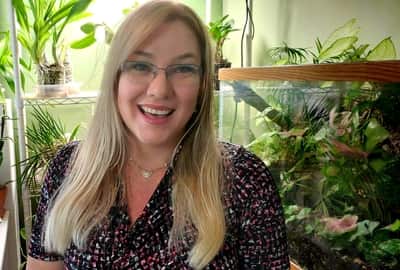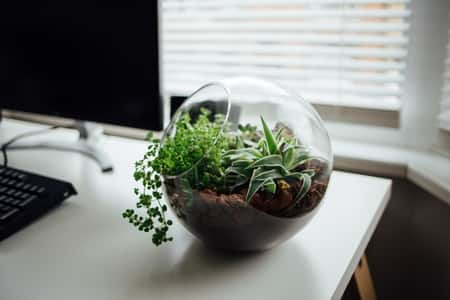Terrariums can come in a variety of sizes, shapes, and models. Open terrariums have outside contact with the environment, lacking a sealed lid to trap the humidity inside the jar.
On the other hand, closed terrariums do not have any interaction with the outside environment despite the few times that you manually take off the lid. In essence, a self-sustained terrarium is a tiny ecosystem where plants and other organisms work together to form a balanced environment. (Source )
)
In these cases, are closed terrariums self-sustainable? And open terrariums? How do you make a self-sustainable terrarium?
Closed terrariums are self-sustainable while open terrariums are not. To become self-sustainable, the closed terrarium recreates the natural precipitation, evaporation, and condensation cycle, all while maintaining the correct balance of gasses inside the glass vase.
Open terrariums will lose the humidity as it evaporates in the air. When outside interference like misting or watering is needed to raise or lower inside humidity, the terrarium no longer is called self-sustainable.

To create a closed terrarium that is perfectly sustainable you have to focus on three aspects of the terrarium: balanced gas exchange, adequate water filtration, and insects that consume decaying material and bacteria.
You have to recreate what nature has already tried and tested, mimicking that terrestrial ecosystem habitat inside a jar. For the terrarium to be self-sustainable, it has to balance out all the factors that are found in the natural ecosystem.
There are 8 major kinds of terrestrial ecosystems:
temperate forest,
tropical rain forests,
deserts,
grasslands,
the taiga,
the tundra,
the chaparral,
and the ocean.
The closed terrarium simulated the tropical rain-forest in the sense that it will be high humidity and filtered light.
Let’s look at these three prerequisites to a successful terrarium independently and see how they relate to a self-sustainable ecosystem: water in adequate proportions, air that is balanced in terms of gas percentages, and critters that can consume decaying material inside the terrarium.
Self-Sustained Terrariums Have a Balanced Humidity Cycle
To recreate that little spot of land in a glass jar that will have no outside manipulation, the water must be added in the correct dose. Remember back to your days in science class where you learned about precipitation, condensation, and evaporation.
As you are planting your terrarium and occasionally misting the soil and plants as you go, don’t get carried away with the amount of water you are adding. It’s always easier to add more water as you go than it is to make the humidity evaporate later.
You can start out with damp soil, but never soil that is too wet.
The water that is in the soil will drain past the filter, which is mesh in my case, and down into the drainage layer. The water will sit in this reservoir for a while until it evaporates back up to the top of the jar.
This drainage layer is of utmost importance to keep your terrarium self-sustained.
The water that just sits in the soil and has nowhere to drain to will decompose the soil. With humidity that has nowhere to go except to the plant roots, the terrarium plants soon rot and wither away.
If you want more information on how to build this drainage layer, this post I wrote focuses on just that. I go over the importance of why it is necessary to have one.
Once the water drains into this reservoir, the roots can dry out properly. The water droplets then evaporate and hot air rises to the top of the sealed jar.
This is where the open and closed terrariums differ tremendously in terms of being self-sustainable. The evaporated water droplets will exit the jar into the room’s atmosphere, be it a home office, your living room, or wherever you have your terrarium. That water is lost forever in terms of ever coming back to the terrarium. For the plants to have water, you have to manually add water, thus becoming self-sustainable no longer applies. (Source )
)
In a closed terrarium, the water will evaporate and hit the top of the glass. There it will condense into water droplets.
Imagine the bathroom mirror after you take a shower. The water droplets are on the glass but when you swipe your hand across the mirror, the water droplets form and run down. This is condensation and is what will water your plants again, as if it were rain.
In this sense, the water is sufficient to not rot the plant roots but still be adequate to hydrate them. This is the beauty of a self-sustainable terrarium. To master the skill of getting the water quantity just right, you need to work with slightly damp material, never overly dry or wet.
If the side of your terrarium is fogging up too much and your plants start to lose their vigor, open the lid and let the excessive humidity out of the jar. It will not be returning unless you mist. Leave the jar open for a few days and close it after the soil is no longer moist to the touch.

Self-sustained Terrariums Perform Gas Exchange
One mistake that I find all too often when building terrariums is the urge to pack the terrarium with plants. Instead of using sand, gravel, pebbles, driftwood or any other type of soil cover, I will pack every inch of soil with plants…and the terrarium suffocates with the smell of death.
Plants do perform gas exchange, as they absorb carbon dioxide and return oxygen and nitrogen. At night, this process can be reversed, but not on the same scale.
In this sense, many people have claimed that plants purify the air. This is true to some extent. In this article, I show exclusively why orchids aren’t a part of that list and why overall, that article is somewhat stretching the facts.
Anyway, back to the point… The plants will be providing gas exchange. Just like the water example cited above, too much carbon dioxide and the plants will die. Too little, the same effect. This is something that we hardly ever think of when creating the terrarium.
With fewer plants in the terrarium, the gas exchange will occur without pressure to one side. With too many plants, the level of oxygen and nitrogen will rise, causing plant tissue deterioration over time.
It’s perfectly fine to not have every area of the terrarium filled with plants. Use decorative rocks over the soil in areas where you do not have plants. Sprinkle sand around edges of pebbles so that the soil is covered but not with a plant. Also, distinct planned open areas in terrariums are extremely pleasant to look at.
Slower growing plants will exchange less oxygen into the closed terrarium, which is exactly what you want when thinking about self-sustainability. Even though orchids are slow-growing plants, I don’t suggest them in totally closed terrariums. If you still want to use an orchid, these are the 5 best orchids to start with.
To maintain a self-sustained terrarium, use less plants. The most common filler plants for terrariums in my opinion are these. Remember they will grow in time so what looks like an empty terrarium when you set it up will sill out nicely in four to five months.
Self-Sustained Terrariums Need a Clean-Up Crew
I love to make terrariums but this is my least favorite part: insects and bugs.
If you close the terrarium with a decent amount of water and enough air in the jar to adequately perform gas exchange, there’s still one more element that needs attention: the clean-up crew.
Death is a natural part of life and it’s normal that leaves die and fall off, that old flowers wilt and fade, and blossoms wither. It’s normal. If your orchid’s blossoms are withering before they should, read this article to know how to detect what the problem is.
Spring-tails are one solution that can come in handy. They will eat the bacteria that builds up and keep the excess leaf litter down to the minimum. I say leaf litter, but it’s in fact the old decaying plant tissue that dies off.
Other critters that are excellent for clean-up crews are isopods. They will also perform the same function of remove dead material from the terrarium, keeping it tidy for longer periods of time. If you want a list of critters to avoid, check out this article about pests that are common in sphagnum moss and this other article about pest that are common in orchid bark.
Even though you’re ready to build a self-sustained terrarium, keep in mind that you will have to open it from time to time. The longest closed terrarium lasted 75 years (from what I’ve heard) but that doesn’t mean it’s your goal. You should open the terrarium every five to six months at the least, pushing it up to a year at the maximum.
The soil cannot provide the same amount of nutrients to the plants that it has been for the past six months and a small dose of fertilizer is always good. When the lid is off, take advantage of the time to trim back the terrarium plants that have overgrown their designated space. You can also mist the leaves for a new thrust of fresh water.
Always keep an eye out for the three items mentioned in this article: good percentage of humidity, plant life (in this case if the plants are growing too fast or dying off too soon), and if you need to supply more clean-up crews.
Don’t Stop Learning!
If you want to be included in more information and get a 14-page fertilization guide, please sign up for my newsletter. I don’t spam, but send emails out bi-monthly with some curious topics of interest. If you want more information, click here to go to a specific page on this website where I explain it more in detail.

Also, if you are looking for an orchid journal to keep your notes specifically about orchid care, check out my 2 solutions for that on this page. If note-keeping isn’t your thing, then there is a free excel spreadsheet that you can download. Click here for more information on how to do that.
If you subscribe to my newsletter, I will send you a 14-page guide on the main tips of orchid fertilizer. It is downloadable and you can print it out on your computer. I designed the guide to double up as a coloring book, just to make it fun.
In all, I wish you the best in your orchid care and in your terrarium builds.
Happy Cultivating!

